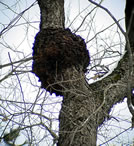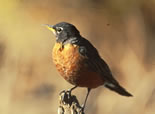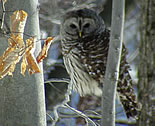
Nature Journal
| |
|
| Sunday, March 2, 2003 | |
| Heard
two white-breasted nuthatches
this morning. They were having an animated exchange using their "ank-ank"
calls. I've been hearing these nuthatches over the past couple of weeks. Some mornings there's been just one - giving it's "hey-hey-hey-hey-hey" call. But on other days, I hear two of them excitedly giving "ank" calls back and forth. I think they may be staking out their breeding territories. |
|
| Saturday, March 1, 2003 | |
|
|
|
warm days in late winter, they tend to come out into the open more - which leads some people to believe that they are seeing the first northward migrating robins. The migrators will come soon, but they're probably not here quite yet. |
|
| Friday, February 28, 2003 | |
| Saw
a female purple finch at my feeder
today - I think... Have seen some males but this is the first female
this winter. I sometimes find it hard to distinguish the female purple finch from the female rose-breasted grosbeak. I didn't get a very long look at her, so I can't be sure. Seemed too small to be a grosbeak, though - and the beak didn't look thick enough. |
|
| Thurday, February 27, 2003 | |
|
|
|
| Wednesday, February 26, 2003 | |
| Saw
some coyote tracks today. There was a
set of larger tracks next to a set of smaller tracks. I believe these
were the tracks of a male and female traveling together. Here's a
photo of one of the larger tracks. It's approximately 2 inches
wide and 3.25 inches long. Mid-February is about the peak of the coyote's courtship period, which usually spans two or three months. During this time, many male coyotes may follow an available female. Once the female accepts one of the males, the pair may travel together for up to a month before mating takes place. The female is in heat for only 2-5 days during the breeding season. It is thought that coyotes pairs remain together for many years - and perhaps for life. |
|
| Tuesday, February 25, 2003 | |
 This
is a photo of a gall on a black cherry tree. This gall was probably
caused by a fungus called Black Knot (Dibotryon morbosum). This
is a photo of a gall on a black cherry tree. This gall was probably
caused by a fungus called Black Knot (Dibotryon morbosum).Here's an interesting site on galls. The introduction describes how galls can, in some cases, actually be beneficial to trees and plants. That's surprising. |
|
still benefit some other species in the forest. For example, certain insects breed in the galls formed by Black Knot. |
|
| Monday, February 24, 2003 | |
| Two
tufted titmice were calling back
and forth to each other this morning. I think they were in flight
- or moving quickly from tree to tree - because the sound was traveling
away at a fairly rapid pace. They were each singing a two-note whistling call - occasionally a single note or three notes. My guess is that these titmice were in the process of establishing their respective territories. Also, a barred owl stopped by early this evening for a brief hooting session before going off somewhere else. |
|
| Top of page |
|
|
| Birds | Butterflies | Mammals |
| Garden Shop |
New England:
Connecticut, Maine, Massachusetts, New Hampshire, Rhode Island, Vermont
 A
neighbor up the road saw a flock of
A
neighbor up the road saw a flock of 